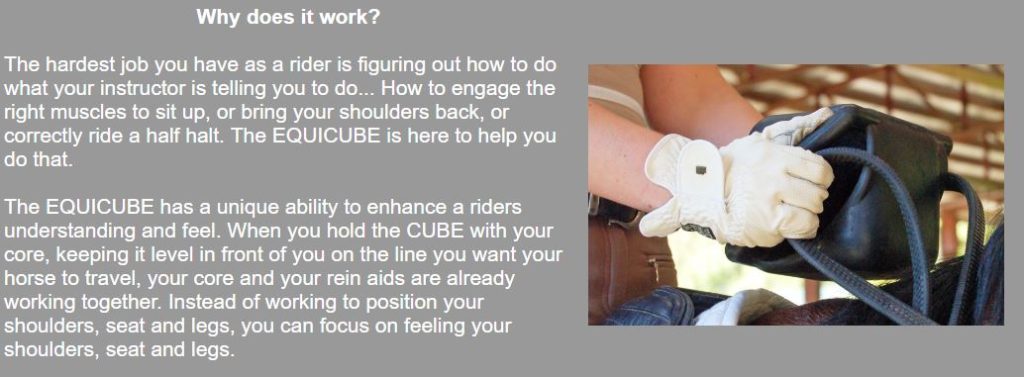I recently stumbled across this teaching tool on the interwebs: The Equicube. It’s a tool that strengthens the rider’s core and helps them find correct posture and ride from their center.
This is it, as shown on their website:
It seems to me the biggest benefits for riding instruction, both for TR and able bodied riders, would be:
1) It helps the rider engage their core, and therefore keep correct posture. The cube forces the rider to engage their abs to counterbalance the weight and keep it steady. If the rider doesn’t know how to use their abs, it directs them how, taking out the inability or guessing. If the rider has lost strength in one of both sides of their abdomen, it can be a nice little guiding workout. So this can be a nice tool for riders who need to improve their core strength and posture.
2) It teaching the rider to use their seat and connect all the aids. Instead of just using direct rein steering, the rider must hold the cube and move it to the left or right to turn, creating both direct and indirect reins, and well as forcing them to use their seat instead of just depending on the reins. Now I haven’t used the Equicube myself, but when I merely pretended like I was riding with one, my whole body connects, aids got subtler, used my seat more, and my horse when so nicely! So this could be the next step for riders who know the basics but need to start using the aids altogether and rely more on their seat than their hands.
It reminds me of something my instructor says, which is to pretend you’re pushing a wheelbarrow, instead of pulling it back. Watching the Equicube videos made me see what that looks like!
When I Googled the Equicube’s use in therapeutic riding, the only thing that came up was an article in the Instructor’s Corner of Therapeutic Riding Inc’s newsletter on page 6, written by Jen Beyer. In the article she writes that when using the Equicube in TR they found:
- it helps rider keep their hands off the saddle
- it helps riders who lean too far back or forward to find the middle/center
- it helps slouchy riders sit up
- it helps riders see how much better the horse works when their position is correct
- it helps riders progress in independence as they need less SW prompts (and develop muscle memory, I assume)
The only other thing that came up was a Facebook post on Scooter’s Place, where they label their barn items, in which a rider made a new label for the Equicube which says “This is a torture cube no matter what the other label says”! Made me laugh.
I’m think the Equicube would be a good tool to use in lessons! As I said, I’ve never used nor owned one of these, but after researching it I would like to. Also, I haven’t paid to write about this, I chose to post about it because I thought it might help someone out, AND I am interested to know if anyone else has used the Equicube in a therapeutic riding setting and what their experience has been? Please leave a comment below!
Sources:
****************
Note: This is not professional advice, this is a blog. I am not liable for what you do with or how you use this information. The activities explained in this blog may not be fit for every rider, riding instructor, or riding center depending on their current condition and resources. Use your best personal judgement! If you would like to contribute an activity or article, please contact me here, I would love to hear from you!

Yes, we have an equicube and have used it for years. I really like it to make riders aware of their hand position, they can feel the weight shift and it brings attention to their hand position. It is pretty heavy to use for young clients, but i use it with everyone from a non verbal teen with autism to our higher level riders.
Yes I use an equicube for most of my riders at some point. it has been fantastic for teaching hand placement as well as developing core muscles as well as teaching steering. I would highly suggest trying one.
Our therapeutic riding center did purchase an Equicube for all the reasons you listed in your post. Our instructors feel it is a beneficial addition to our “toolbox” and would recommend it. It can illicit some groans from certain riders because they know it’s going to be a workout, but for those who like a challenge it’s a great teaching aid.